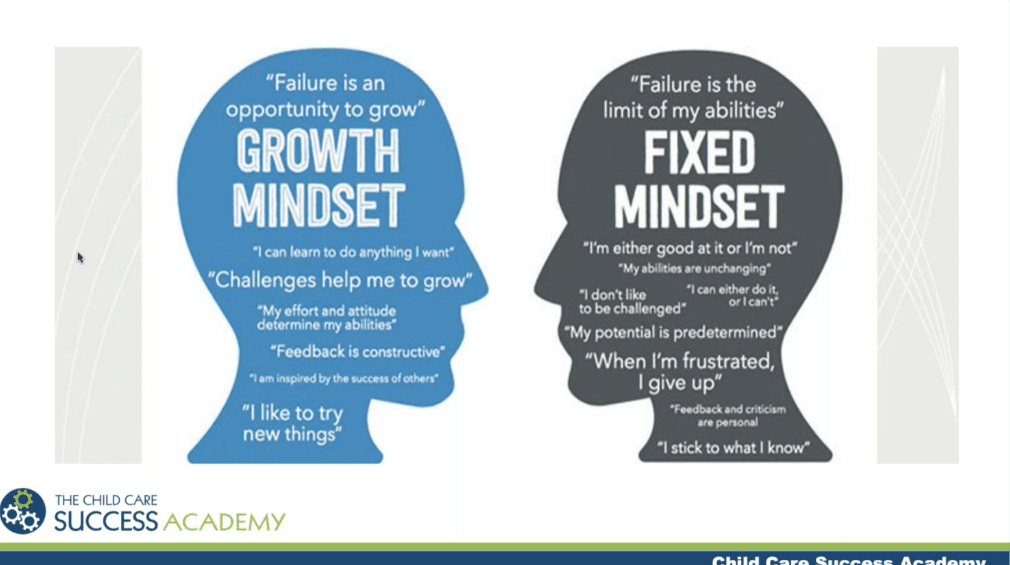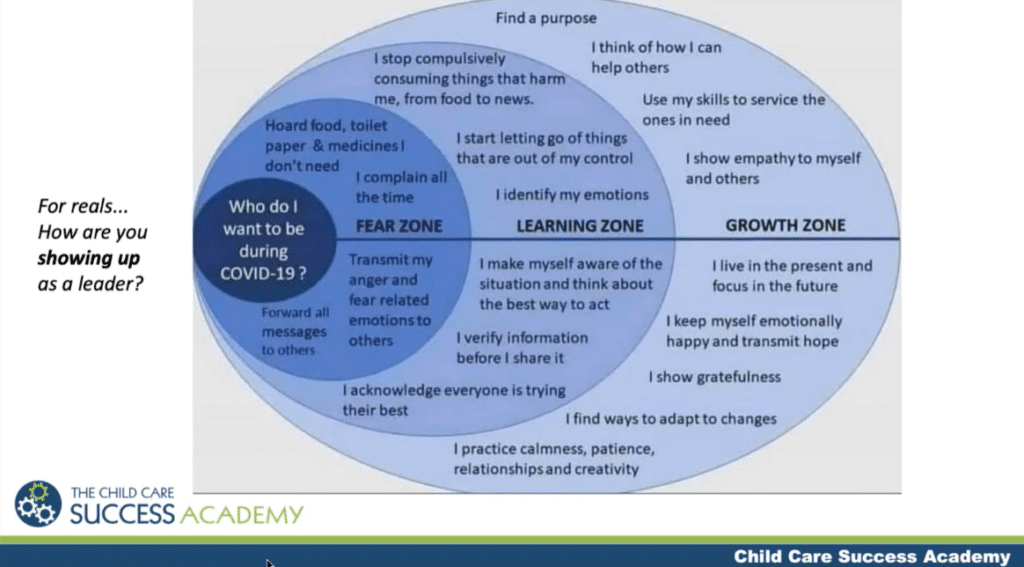
Running a child care business is a challenging endeavor on a normal day, but doing it amidst a global pandemic? The stakes and stress are ratcheted up to a whole new level. And that means it’s really easy for child care directors and staff to get overwhelmed.
So how to combat it? First, it’s important to know that you’re not alone – overwhelm in the child care space is extremely common. Second, take a look at where the overwhelm stems from. According to Kris Murray, President of The Child Care Success Company, getting caught in what she calls the “loop of overwhelm” is caused by these three root causes:
- Not enough time to delegate
- No one to delegate to
- Not enough revenue/enrollment to solve the problem.
Once you identify your root cause, you can start to take action on eliminating the overwhelm. And that involves a four-step process.
“It’s a simple four-step process that will help you eliminate the loop of overwhelm, but you have to recommit to yourself, to your program and to your team to see the results,” Kris said.
Step 1: Believe You Can Do This
You need to have the right mindset when tackling overwhelm – a growth mindset. Take a look at your negative self-talk and limiting beliefs, recognize them for what they are, and know that those thoughts are going to keep you in a fixed mindset. Here’s a visual to show the difference between a fixed and growth mindset:

For Kris, it’s all about mindset before skillset. You should focus on having ambition, a good work ethic and attitude, and stay away from negative people, who will slow down success and hinder your growth.

To help cultivate a growth mindset, Kris has a daily mindset practice, which includes many or all of the following:
- Pray every day (you can obviously sub out to something else if you are not a spiritual person)
- Watch a positive mindset video every morning
- Read some of positive quotes
- Read a chapter from a personal growth/development book
- Find someone who needs their “bucket filled” and talk to them
- Re-connect with family and friends via Zoom
- Cry when it feels overwhelming
Step 2: Actively Manage Your Calendar
Actively managing your calendar is all about being disciplined and setting boundaries.
“How you approach your day is everything,” said Kris. “I like to plan out my calendar at least a week in advance, and I use time-blocking strategies to ensure I have periods where I can really dig into the work I need to get done.”
Time-blocking is a strategy where you block out time on your calendar to tackle any projects, trainings, etc. This could be a standing block of time, meaning it’s the same day/time every week, or it could vary depending on the week. The key is that you block the time in advance so it doesn’t get scheduled over with other things, and that the time you block is during your “productivity zone,” when you typically are able to focus the most. Kris acknowledged that for many, finding time to block out can be really hard.
“The reason many of you are overwhelmed is because you have too many priorities,” Kris said. “So, what I like to do is rank everything on my calendar on a scale of one to 10, with 10 being a ‘must do or my business will close.’”
Once you’ve ranked everything, Kris advised to look at the ones and twos, and either delegate them to a team member, or put them on a “not right now list.” She said delegation is one of the biggest issues she sees among ECE directors.
“I often hear from administrators that they can’t delegate, because by the time they bring that person up to speed, they could’ve gotten it done themselves,” Kris said. “That’s really not true. A lot of the tasks you take on are easy to hand off to someone else, and the great thing is, once they’re up to speed, they can keep assisting you on those tasks.”
Some additional tips Kris offered include:
- Address “time vampires,” or those who tend to dominate your time with their needs or to chit-chat. Lovingly address it, perhaps in a staff meeting, letting team members know that during specific hours, you need to be left alone to tackle the needs of the business.
- Set specific times each week where you do tours, calls with parents, etc. and do them all in one chunk. That way, you’re not switching between different tasks that require different mindsets.
- If you can’t afford to hire additional full- or part-time employees, consider commissioning the help of freelancers for short-time assistance (for example, getting you up to speed on your accounting software or helping you organize reports or other business documentation). Examples of services include Fiverr.com and Upwork.com. You can also look at trades with your parents. For example, if a parent is a website designer, you could offer them free child care in exchange for a new website design.
- Think about getting your staff on a shared calendar system like Google Calendar. That way, everyone can see your calendar and knows when you’re available to meet with them on center issues/needs.
Step 3: Intensely Focus on Getting and Keeping Clients: Full Enrollment and Consistent Rate Increases
Focus is the key in this step – how focused are you on enrollment? Here are some questions to ask yourself to make sure you have what you need to cultivate a strong enrollment-building focus:
- Do you know your key stats like leads, tour conversion and retention?
- Do you have a proven enrollment-building process and system in place?
- Are your people trained on it?
- Do you know your “3 uniques?”
Make sure you know the answers to these questions, which will support your ability to fully understand your enrollment situation and be able to market to families more easily when you have spots to fill.
When it comes to growing enrollment, Kris said two things really make the difference in this area:
- A good website: This is where most parents go when researching your business, so make sure it’s a clear reflection of your values and philosophy. Also ensure it provides all the relevant information parents are looking for, particularly around your COVID-19 procedures.
- A reliable email marketing platform (i.e. Mailchimp): You need to keep in regular contact with families (both current and prospective). By leveraging an email marketing platform, you can streamline your outreach and ensure no one falls through the cracks. (Note: You can do this through Procare’s Parent Engagement solution.)
Tours are a big part of growing enrollment, but in today’s environment, it’s all about going virtual. Child care centers can do virtual tours in a variety of ways, including an open house event, where they invite multiple families to attend at once, or one-on-one tours. The key to a successful tour is to practice ahead of time. Kris recommends a selfie stick or similar technology that helps steady the camera/phone being used. Do a dry run of your tour and record it – then re-watch it and figure out any changes that need to be made before the virtual event.
Kris also talked about rate increases. Many centers are hesitant to do rate increases, especially now, but the fact is, centers are paying more for cleaning equipment and other items related to mitigating the spread of COVID-19.
“Your child care center is still a business, and rate increases are a typical part of the cycle,” said Kris. “Parents will support your rate increases – and if they don’t, they weren’t your people to begin with.”
Step 4: Money Management
Managing your money is not a situation where you want to wing it, even though many child care businesses do. To be successful, you need to develop and review monthly financial statements, know your profit margin and know your break-even numbers. According to Kris, “cash is the oxygen that runs your business.”
“I see child care administrators who don’t have financial statements, don’t use account software and don’t know if they’re making or losing money – they go based on what’s in their bank account, which is not a sound business practice,” Kris said.
This is an area where child care management software can help tremendously, as it takes a lot of the guesswork out of doing financials and streamlines all your reports. This software is especially helpful for those who don’t have a business background.

Kris advises that once you start drilling down into your financials, you can arm yourself with the data and the confidence you need to make smart business decisions. One recommendation is to create a quarterly Revenue/Cost Projection spreadsheet like the one below so you can better anticipate your financial needs.
“Hope is not a strategy,” said Kris. “You are the CEO or top leader of your company, and it’s incumbent on you to use data to make the tough – but informed – decisions and execute your company’s plan. By having a plan in place, you’ll sleep better and feel calmer.”
To learn more about how to overcome the loop of overwhelm in child care, check out Kris’s webinar with Early Childhood Investigations.
To learn how you can use child care management software to get your financial house in order, talk to one of our experts.



